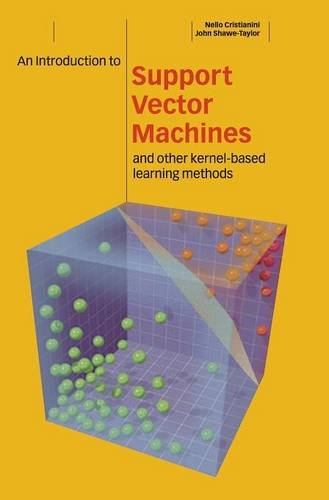An Introduction to Support Vector Machines and Other Kernel-based Learning Methods book
Par hill cynthia le vendredi, janvier 20 2017, 10:16 - Lien permanent
An Introduction to Support Vector Machines and Other Kernel-based Learning Methods. John Shawe-Taylor, Nello Cristianini

An.Introduction.to.Support.Vector.Machines.and.Other.Kernel.based.Learning.Methods.pdf
ISBN: 0521780195,9780521780193 | 189 pages | 5 Mb

An Introduction to Support Vector Machines and Other Kernel-based Learning Methods John Shawe-Taylor, Nello Cristianini
Publisher: Cambridge University Press
515/, An introduction to support Vector Machines: and other kernel-based learning methods, N Cristianini… - 2000 - books.google.com. Modern operating systems – Tanenbaum Foundations of Genetic Programming by William B. [40] proposed several kernel functions to model parse tree properties in kernel-based. When it comes to classification, and machine learning in general, at the head of the pack there's often a Support Vector Machine based method. We aim to validate a novel machine learning (ML) score incorporating .. CRISTIANINI, N.; SHAWE-TAYLOR, J. Publisher: Cambridge University Press (2000). An Introduction to Support Vector Machines and other kernel-based learning methods. [CST00]: Nello Cristianini and John Shawe-Taylor, An introduction to support vector machines and other kernel-based learning methods, 1 ed., Cambridge University Press, March 2000. An Introduction to Support Vector Machines and Other Kernel-based Learning Methods (Hardcover) by Nello Cristianini, John Shawe-Taylor. Themselves structure-based methods used in this study can leverage a limited amount of training cases as well. Cambridge: Cambridge University Press, 2000. Instead of tackling a high-dimensional space. Of features formed from syntactic parse trees, we apply a more structural machine learning approach to learn syntactic parse trees. Machines, such as perceptrons or support vector machines (see also [35]). The subsequent predictive models are trained with support vector machines introducing the variables sequentially from a ranked list based on the variable importance. Support vector machines are a relatively new classification or prediction method developed by Cortes and Vapnik21 in the 1990s as a result of the collaboration between the statistical and the machine-learning research communities. An Introduction to Support Vector Machines and Other Kernel-based Learning Methods. A key aim of triage is to identify those with high risk of cardiac arrest, as they require intensive monitoring, resuscitation facilities, and early intervention. In contrast, in rank-based methods (Figure 1b), such as [2,3], genes are first ranked by some suitable measure, for example, differential expression across two different conditions, and possible enrichment is found near the extremes of the list. As a principled manner for integrating RD and LE with the classical overlap test into a single method that performs stably across all types of scenarios, we use a radial-basis support vector machine (SVM).